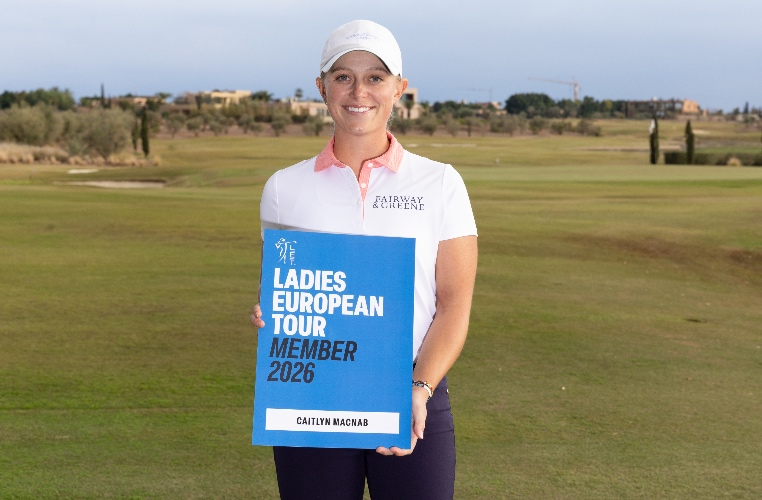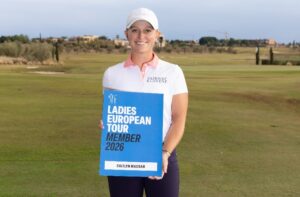 |
| Swedish stars Sorenstam and Koch |
Q. Catrin, what’s the strategy for tonight? CATRIN NILSMARK: It’s to somehow keep this girl not under control. I think that’s going to be easy. We actually moved the dinner forward a little bit. It was planned for 7:00. I did get a bit worried thinking about four hours of celebrating could be a little hard. So we moved it up to I think 6:00, did we? Yes, 6:00 dinner. It’s a barbecue and from then on it will be dancing. Not me, but everybody else. I’ll sit in the middle and watch them.
Q. For Catrin, how will you prepare the team to be able to win in the U.S.? CATRIN NILSMARK: How will I? I’m not so sure I’m the one that’s going to do that.
Q. You’ll have to hand the team then to someone. CATRIN NILSMARK: I have to hand the team over, yeah. I think no, I think they know. I think we’ve learned a lot this week. We had a bit of a problem with the Sunday before, but I think we pretty much won every day this weekend. It was great confidence to go out and play so well today I think for the girls. I do think we can leave that behind us now, the Sunday singles and just move forward from there.
Q. To everybody, after Loch Lomond, you all traveled back with the U.S. team on the charter back to the States. Show of hands, how many are going back on the charter this time? (Catriona Matthews and Janice Moodie showed hands.) CATRIN NILSMARK: The Scots.
Q. Catrin, would you like to captain the team next time? CATRIN NILSMARK: I really don’t know. I don’t think so, honestly, because I don’t think I’ll be playing over there in two years time. It really depends on I think where I play. It’s been an advantage to play on both sides because I know these girls so well, and I know the U.S. team so well. And I think it’s easy to coach if you know each and every one. What makes them tick and not tick and all this stuff. And I’m not so sure I’ll be playing in America. I think it’s highly unlikely I’ll play there in two year’s time. Probably not. But it’s something I haven’t quite decided if I do get the question.
Q. In that case, who would you like to see as captain? CATRIN NILSMARK: Well, I think Allie is more than ready to take over next time. She’s been an unbelievable vice captain. I don’t know Allie’s plan with golf and how she feels in terms of knowing the girls and all that. But she would certainly be a splendid choice.
Q. Catrin, today you went in with the team for the ceremony. Does that mean you’re feeling a lot better, or is this just the power of victory? CATRIN NILSMARK: The adrenaline is pumping around pretty fast in the body. I do feel a lot better. I think I’ve improved every day. It’s very slow, it’s an improvement every day. I was actually thinking about that when I was standing oh, my God, that wasn’t even in my head to do that on Thursday. And that was just three days ago. I’m happy.
Q. Annika, as everyone knows you’ve had quite an amazing year with a few high spots in it. How does this compare being in Sweden, being on a winning Solheim Cup team to everything else you’ve been through this year? ANNIKA SORENSTAM: It just pretty much summarizes the year, really. Obviously I’m very delighted to be part of this team and to win on home soil. It has been an incredible year for me. I’m just trying to enjoy every moment. You don’t know how many more you will get, but I sure enjoy it.
Q. Iben, you looked very confident during the round in the beginning especially. After 6, 7, 9, you’re 3 up. And then you lose 11 and 13. How did you feel after having lost those two holes? IBEN TINNING: I was feeling all right because I thought I was playing good. She wasn’t hitting the ball as she normally does. So I knew I was just trying to get to the greens in regulation and try to get some pars and maybe sink some birdies. That’s what I did.
Q. And then you had the dream shot on 17. Are you going to qualify for the American tour? Are you going on to the American tour? IBEN TINNING: I’m trying to qualify this year, see if I make it, yeah.
Q. Just to anybody who wants to answer. How does it feel to go out there and see all the blue spots on the score board? CARIN KOCH: Really good. CATRIONA MATTHEW: I think it was great to see the first people doing well like Janice and Iben and everyone getting their points on the board. It was a big boost to me I know certainly. It’s much better to see blew up there than red. CATRIN NILSMARK: It’s normally, I’ll just have to say one thing. It’s normally a huge difference for the crowds. If they don’t see any blue, it’s hard for them to keep going, “Europe, Europe”, and things can die out pretty quickly. So not just for the players, but for the crowds it’s even more important, I think. And then in turn we get more of a boost.
Q. Laura, we touched just a little bit about this before we started. This is the first time that the U.S. doesn’t hold either the Solheim or the Ryder Cup. What does it say from the European side? LAURA DAVIES: It speaks for itself. The Americans have to go up against all the other countries together. It’s still a very strong team. I think when you put the combined forces of all the European countries together, it’s you’ve just got to look at the talent around the table.
Q. It seems like for a long time the Ryder Cup and early on in the Solheim Cup the perception for America was, Europe, just bonds better, plays as a team better. I wonder now if we’re reaching a stage in the last couple of years where the talent gap is almost minimal. LAURA DAVIES: If you want to put the collective European team up against the collective American team, then yeah, the level is every tournament, every Ryder Cup, Solheim Cup comes down to a pretty close Sunday. Obviously the way the match is at the end the gap is big, but only because the matches were conceded. Anything can happen towards the end. It always proves to be a close.
Q. Laura and Annika, in the nicest possible way, you’ve both been around and competed in these matches for a long time and had a lot of experience. Could both of you, please, identify one thing about this match, other than winning, that would stay in your mind and will always come to mind when you think of the 2003 Solheim Cup. LAURA DAVIES: I think for me it’s the crowd. Walking the fairways, 15 20 deep, especially around it seemed like 7 and 8 was huge, and you walked through there, you had a big lift down 9, 10, 11. You looked forward to getting to that part of the golf course. And then you come down 16, 17, 18. For me the memory is the crowd. ANNIKA SORENSTAM: I agree totally with Laura. The crowd, I thought they were spectacular this week. Obviously they were very supportive of the Europeans. But I thought they were also a good golf crowd. I’m very proud for being a Swede to see so many Swedes out there. Obviously the tournament itself I felt was very well organized, very professionally done.
Q. Catrin, how much were you watching the board and kind of calculating in your mind playing it out? Was there a particular match as the day unfolded that you thought was particularly pivotal? CATRIN NILSMARK: I was very happy to see that my strategy was to get two points out of the first three or I felt that that was quite important. And then I was following Beanie’s match, Catriona’s match pretty closely. I felt like that was a key match. Early on in the day, let’s say halfway through the day, Iben’s match and Catriona’s looked extremely important. Although then at the end Mhairi started to play really well, and she got 1 2 3 up. So even when Iben went back to 1 up I felt pretty confident because at that time Mhairi had started to get up. At a certain time it sure looked like it could go either way, which it always can do in match play. Catriona’s and Iben’s matches, I followed them pretty closely.
|
|



















